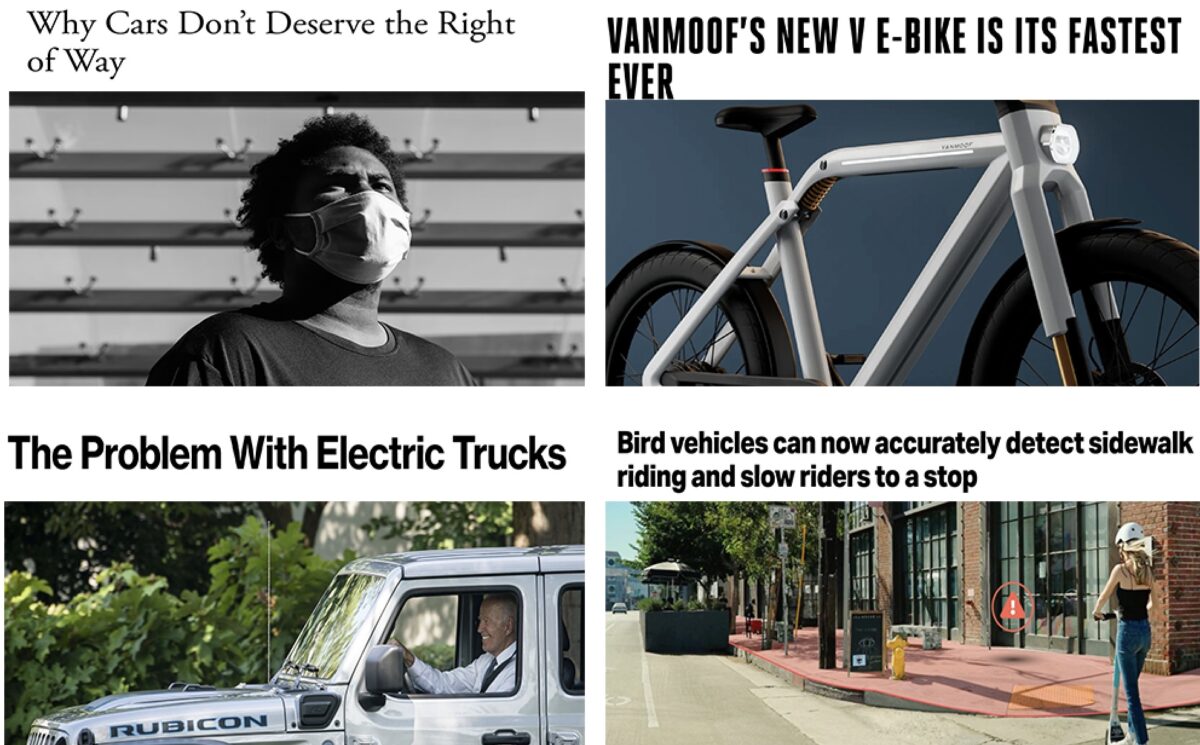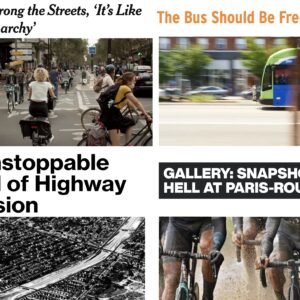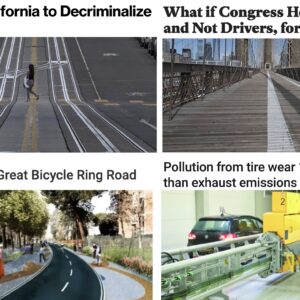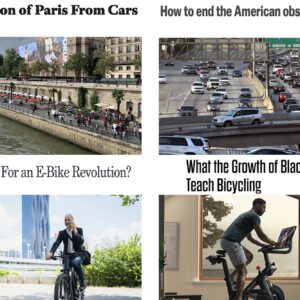Welcome to Monday.
Here are the most notable stories our editors and readers came across in the past seven days.
But first… This week’s Monday Roundup is made possible by Nossa Familia Coffee, a Portland-based company who gives 50 cents from every bag of their yummy Full Cycle blend to organizations working to build a healthier and more accessible community through cycling.
Now let’s get you caught up…
Neighborhood of the future: This profile of the “15-minute city” vibes on Clement Street in San Francisco is an intriguing view of how cities and neighborhoods have changed/should change as we adjust to the new Covid normal.
VanMoof’s activism: VanMoof is calling out the paternalistic regulations on electric bicycles with their new, super-fast e-bike and I’m excited for the debate it has sparked.
Bikes at war: Bikes were used by troops in World War I, now the Australian military thinks it might be time to use them again. This time around however, they’re testing silent models that can reach speeds of 55 mph!
What about cars: The technology to prevent people from using electric bikes and scooters dangerously is truly impressive and it begs the question: Why the hell aren’t car companies installing similar tech in their cars and why aren’t cities forcing them to?
Biking while black: A new research paper not only draws a clear line between a lack of bike lanes and more ticketing of Black bicycle users, it also says more bike infrastructure would lead to more racial justice.
Opposed to traffic enforcement? Read this: “It’s incoherent to oppose traffic enforcement and support automobile hegemony if you’re a progressive,” says emerging, Berkeley-based urbanist leader Darrell Owens.
Advertisement
More on Owens: The Atlantic went deep into Owens’ impact on the Berkeley traffic policing and infrastructure debate and his impressive push for “self-enforcing” streets where traffic cops would be made obsolete by design.
EV trucks are just deadlier weapons: The leader of Transportation Alternatives is sounding the alarm about how the auto industry’s embrace of electric trucks is a greenwashing campaign, “that will make our streets run red”.
The self-driving car myth: Author Peter Norton shares about his new book that exposes how the narrative that cars will drive themselves is part of yet another propaganda push from the auto industrial complex to hide the vast negative externalities of their products.
Schumer on a bike: I recall when NYC was cracking down on Manhattan’s ubiquitous e-bike food delivery riders, now one of the most powerful politicians on Capitol Hill, Senate majority leader Chuck Schumer, has done a ride with them and is promising infrastructure to make their jobs easier.
Video of the Week: The UK’s “Bike is Best” campaign has a fantastic new ad:
A quarter of our car journeys are under 2 miles.
When more people cycle, everybody wins.
Our new #BikeIsBest ad is now live.pic.twitter.com/yA9f6BwFQt
— Adam Tranter (@adamtranter) October 15, 2021
— Jonathan Maus: (503) 706-8804, @jonathan_maus on Twitter and jonathan@bikeportland.org
— Get our headlines delivered to your inbox.
— Support this independent community media outlet with a one-time contribution or monthly subscription.








Thanks for reading.
BikePortland has served this community with independent community journalism since 2005. We rely on subscriptions from readers like you to survive. Your financial support is vital in keeping this valuable resource alive and well.
Please subscribe today to strengthen and expand our work.
More on Owens:
“In fact, before cars, ordinary citizens rarely came in contact with law enforcement.”
I’d love to see the cited 1910 or 1897 study of police-citizen interaction rates – I’m sure it’s fascinating, especially as the author builds so much of their argument on those hypothetical studies.
It’s sad to see such “reputable” journals as the Times and Atlantic fall to the levels of Fox News on publishing such false statements and uncorroborated data on the assumption that if you repeat it enough, eventually everyone will believe it is true.
David… Pretty sure that fact comes from the research and book written by Columbia Law School professor Sarah Seo https://sarah-seo.com/
Not sure how you jump from that to claiming The Atlantic has fallen to the level of Fox News.
I think David is taking more at issue with what seems to be a subtle narrative that seems to be pushed that sort of ties in every progressive policy position on policing/cars/racism in to a very neat storyline and almost forgoes any attempt at nuance when discussing these topics. It ends up wrapping good ideas with a certain degree of intellectual dishonesty.
Thanks Shimran. I hear you on that. I reflexively detest narratives that lack attempt at nuance and am very sensitive to the phenomenon you lay out.
Thanks Jonathan…I do believe those are your values given your willingness to accept opposing viewpoints!
(And apologies in general for the run-on sentence and the slightly awkward passive voice. I wrote my comment in a rush but I am committed to some degree of grammatical integrity!)
JM, I just checked the link you sent – a few articles but no data links, not even refereed journal articles – just a lot of opinion.
There is an Academic Writings section in the Publications tab of her website. Or I can save you the hassle: https://www.yalelawjournal.org/pdf/c.1616.Seo.1671_g1716r6t.pdf
It is annoying when people make incendiary claims without checking for the evidence first. Owens does generally do his homework; you, apparently, do not.
The link is helpful. Thank you.
Can you get me a link to the actual statistical data to prove the statement “In fact, before cars, ordinary citizens rarely came in contact with law enforcement.”? Thank you in advance.
I think the argument is not based on specific stats or studies, but an understanding of historical and legal facts, as asserted by Seo’s scholarship.
https://www.google.com/books/edition/Policing_the_Open_Road/nlWQDwAAQBAJ?hl=en&gbpv=1
P.13
“Certainly, policing as a mode of governance affected some groups more than others. But just as importantly, it changed the dynamic between all individuals and the police. Before cars, officers mainly dealt with those on the margins of society like vagrants and prostitutes. Voluntary associations governed everyone else. Churches enforced moral norms, trade groups managed business relations, and social clubs maintained social harmony. To be sure, the force of state power was palpable and vast, but the presence of the police was minimal because the “well-regulated society” of the nineteenth century, to use one historian’s description, was self-regulating in that it depended largely on communal and private enforcement.17″
I can’t see the citation (17, should be on p.282 but it isn’t included in the preview)
Pages 13-15 expand on the argument
Not saying it’s right or wrong, but not everything needs to be understood by a qualitative study or data, especially the further you go back in time. In fact, I’d be wary of any sociological data collection methods from that long ago for something like “interactions with law enforcement”. This doesn’t mean we can’t know anything about it, it just needs to be discerned by other means, e.g. laws, cases, training documents, dairies, etc. From reading her intro, it sounds like private security with fewer powers (vis-vis her main focus, the 4th amendment) were what the “Everyman” interacted with prior to the mass automobility.
Right, I agree there’s the logical argument, which you’ve summarized very well, but that isn’t what Owens says – Owens instead makes a provable (or disprovable) assertion presumably based presumably on data that probably doesn’t exist – and that’s why I find such an article comparable to the baseless assertions that Fox News (among others) frequently make and that many people believe. The fact that the article came from the Atlantic presumably means that it was fact-checked first – and clearly it wasn’t.
We don’t have good data on contemporaneous citizen-police interaction rates, let alone a continuous historical data source going back 100 years, which we would need for the sort of longitudinal study you’re imagining. If someone claimed to have such a data source, and preformed some diff-in-diffs or regression discontinuity analysis on it, I would probably treat that study with more skepticism than the holistic review of legal documents that Seo lays out.
Like Steve C said, quantitative studies are not the only way to develop an understanding of history. I say that as a statistician.
Is there any indication that the assertation is based on data in the first place?
Honest question. Do you typically read about history? There is rarely clean data points.
You not doing the work to understand what the author is saying is not the same as Fox News, which spreads literal misinformation and lies.
Well, did you read the uh, book that JM is referencing? I’d guess that there’s probably more information in there than you get from a 5-minute skim of the authors website.
Sarah Seo’s book, Policing the Open Road, is very much about how we came to be policed, with a ton of footnotes as I remember–solid, solid academic research.
Here’s my BP review from April.
I see all the footnotes, but no actual data nor any references to data, just lots of case law and anecdotal evidence. Again, the sentence “In fact, before cars, ordinary citizens rarely came in contact with law enforcement.” is a provable hypothesis, but no one is bothering to prove it, which makes me think it may be wrong. The author even says a lot of it was complaint-driven rather than statistical evidence.
David, it is history. You learn things by going through old records, looking at log books, reading letters . . . Read the book, it’s good.
History is an interpretation – an qualified opinion if you will – of what may or may not have occurred. Various assertions were made, that regular folks in the USA didn’t interact with the police before the car became popular. The reality is that individual car ownership wasn’t popular until the 60s, but most of these laws were enacted in the 20s and 30s. In Germany, common car ownership wasn’t until the 1970s, but its society has had several periods of heavy interaction with the police in the 1933-45 period and the Stasi in East Germany 1950-1990. Any society that is totalitarian or autocratic is going to have constant police interaction whether automobile ownership is popular or not.
African-Americans and other visible minorities in the USA are mare likely to be harassed by police if they are walking or bicycling, but Owens ignores this. His focus is instead on car ownership and who writes the tickets for violations.
“Various assertions were made, that regular folks in the USA didn’t interact with the police before the car became popular. The reality is that individual car ownership wasn’t popular until the 60s, but most of these laws were enacted in the 20s and 30s.”
I think this is a mischaracterization of Seo’s argument, though because Owens seems to have imprecisely generalized this fact, his statement could be interpreted that way. And in that sense I agree with your criticism of Owens’ words. It was an odd undefined and unsupported claim that needed more explication in the context of the article.
But Seo makes a historical and legal argument about white upper and middle class Americans and their evolving relationship to the police in the early 20th century. She pretty clearly talks about the increasing popularity of household car ownership in these demographics as early as 1920 and the legal issues police faced when trying to control a group of people not accustomed to being “contacted” by the police.
When she says “everyman” in a legal sense she is speaking about white people of a certain class and their relationship to police and law at that time. When Owens brings up this fact, I believe he is asking us to imagine a modern version of the low police contact pre-car state, but with the franchise of “ordinary people” now having been extended to a broader swath of American society, including POC. We could certainly argue convincingly that that American society is still deeply unequal and racist, that “ordinariness” is still withheld from many people. But I don’t think that is the point, he clearly intends for all people to be included.
Also, I do not think Seo or Owens is claiming that the root cause of authoritarianism, in a general sense, is the adoption of cars and the particular American response to their early popularity. So wither cars were or were not adopted in Germany, Italy, USSR or whatever is beside the point. American legal responses to auto-mobility did however produce an expanded power to arrest the public and subject them to search and prosecution that didn’t exist, and more importantly for us today, she claims didn’t need to exist.
It seems to me that Seo and Owens both want to see non-police traffic enforcement so that search and seizure constitutional questions and the violence that can result from them would be less of an issue. She points out that this relationship with police was not wholly unheard of, and based on her research, it existed for certain white people prior to ~1920. Owens asks us to extend that once extant privilege to all.
I totally believe this statistic. With so many citizens in bygone days being farmers and living in rural areas (including my grandparents), encounters with law enforcement personnel would have been few and far between. But putting this aside, why get so upset about the veracity of an innocuous fact? There are so many evil lies being propagated by dark money these days – why not combat those instead?
Whatever you want to believe is all very well, but it isn’t really a “statistic” if there’s no data nor source. You might as well believe that the Bible is the word of some god – as many people do.
Statistics and fulfilling ancient prophesies are different.
Amen.
I think the real point is not the nitty gritty of the statistics but that the introduction of the automobile fundamentally changed the interaction of citizens with the police and even more so the entire interaction of the citizens with crime and criminals. This was also a huge difference in these two things between cities ( where crime and police response took place on foot) and the rural areas and frontier where only such interactions could take place on horseback but the range of crimes more or less consisted of horse theft, rustling and murder. My great grandmother who spent her life ( on foot0 on homesteads in Southern Oregon and Montana left a journal and specifically mentioned living her entire life without meeting a law enforcement officer of any kind.
I’m not sure I’m getting the point. Is it that we should rely on vigilante justice, trial by mob, and lynchings like they did in the good ol’ days where everything was apparently more equitable?
Didn’t read the article, but did they address confounding variables like higher population density correlating with greater police actions?
The dispatch on Clement street was nice and reflected what I observed there this Summer pre-delta. To me it illustrates how flexible traditional urban development is and how the 15 minute city is just reclaiming that traditional development pattern which is focused on pedestrian travel.
I remember listening to a pro-buy local story on NPR several years ago (back when I listened to npr) in which the sole black interviewee claimed that he preferred big box stores to his local lumber yard, because at the big box he was guaranteed to be charged the same price as everyone else, whereas with the local store he was never sure.
This strikes me as a similar trade-off to the Darrell Owens “BerkDOT” strategy. Sure, you get safer streets, less potentially negative interactions with law enforcement, and it’s probably cheaper overall. On the other hand, ubiquitous surveillance state anyone? Maybe it’s worth it maybe not. Nothing is an unalloyed good.
As for the Atlantic piece itself, if you ignore the woke lies, half-truths, insinuations, and jargon baked into it as facts, it could have been good.
Do you really think you don’t currently live in a surveillance state? Your phone invades your privacy far more than a traffic camera.
You have to get a drivers license to drive. You have to (in most places) get a license plate to drive your car. You shouldn’t have anonymity while driving.
I think the real push back for traffic cameras is that most Americans feel they have a god-given right to break traffic laws and cameras make that significantly harder. Hell, it’s baked into our laws that you are allowed to break the traffic laws up to a certain point before you get in trouble.
So your argument is that you’re already spied on all the time, why care about a little more? That’s the same sunk cost fallacy the junky uses to justify his next hit.
My point about the surveillance state is if the city does commit to traffic cams, do you think that’s all they’re going to be used for? Or do you think that in 20 years time the “Darrell Owens” of the future will be railing against the “racism” of automated police surveillance in his neighborhood?
From the Barajas study:
The VanMoof electric bike goes 37mph. That’s all well and good, just don’t ride your moped in the bike lane.
This is something that I was very annoyed at before I bought an e-bike. The seemingly inconsiderate speeds they can travel. Especially in constrained locations like the Hawthorn Bridge sidewalk. I think there’s definitely a risk of the new rider – one without years of experience riding an acoustic bike – not having the background to understand what it’s like to be passed by someone at speed. Then again, there’s plenty of folks on acoustic bikes who ride inconsiderately, so I don’t think it’s worth guarding the gate on that one.
Another benefit of pedelec e-bikes, that is seldom discussed, it’s actually better for your overall cardio vascular (CV) health.
Cyclists tend to have CV health issues.
https://www.velonews.com/gear/technical-faq-cyclists-and-heart-issues/
Pedelec riders have ~94% heart rate of acoustic riders.
https://formative.jmir.org/2019/3/e13643/
This 6% difference means that you still get healthy exercise, while avoiding long term damage to CV health.
A Zinn blogpost about uber-roadies “overdoing it” has nothing to do with transportation cycling and is also an anecdote.
Commuters are just as susceptible to overdo it as “uber-roadies”. Add to the base line effort of commuting, you have heaps of stress hormones in your body from being surrounded by cars. As well, a typical commuter isn’t wearing skin tight spandex and riding an ultra light bike. So, the base line effort is fairly substantial. And if you are a commuter, you probably do a lot more by bike than just go to and from work. Such as running errands.
https://academic.oup.com/eurheartj/article/36/23/1445/2293352
Additional reading.
https://www.ahajournals.org/doi/full/10.1161/CIRCULATIONAHA.110.981571
Uh, no. Bike commuting is not damaging people’s hearts en mass. You are reading these publications incorrectly.
I didn’t say that commuting is damaging people’s hearts on mass. I said e-bikes reduce the potential for that sort of damage. Please don’t straw man me.
How does reducing the average heart rate of a group result in improved individual cardiovascular health? There are just too many variations between individuals to make sweeping statements about benefits, unless, as a general rule higher heart rates cause cardiovascular damage, en mass. The benefits of exercise strongly out way any putative risk from over doing it, especially in the context of commuting.
“This 6% difference means that you still get healthy exercise, while avoiding long term damage to CV health.”
So I lower my average heart rate by 6% and presto, avoid heart damage?
I’m not trying to put words in your mouth. I just simple don’t understand the logic of lower hr = avoiding heart damage. I don’t think you can make this blanket assertion. And I feel like you might be overstating the dangers of exercise on the heart.
“it’s actually better for your overall cardio vascular (CV) health.”
Who is the “your” in this statement? Everyone? Most people? Some people?
Elevated heart rate is good, for short periods. Elevated heart rate for extended periods of time is not healthy. In the extreme, this can lead to cardiac arrest in marathon runners.
https://www.ahajournals.org/doi/10.1161/JAHA.119.014408
However, the threshold is not known. Is ten minutes too long, what about 20 minutes?
https://www.ncbi.nlm.nih.gov/pmc/articles/PMC2941782/
There are no silver bullets. Please don’t misquote / straw man me.
In general, everyone. The more hours you spend on your bike, the better off you’d be on a ped-elec. Engaging in strenuous exercise for extended periods may make you think you’re going to get buff, but it can actually be too much of a good thing. In the extreme, consider marathon runners and cardiac arrest.
You know that if you put the toaster at maximum setting, the bread burns, right? Same thing, there’s toasted and then there’s burnt.
The link between exertion and damage is evident. The question is, where is the threshold. There are a lot of considerations to make. However, you can evaluate your own risk by using a heart rate monitor during your transportation cycling. You may be surprised at what your actual heart rate is at any given time.
Also consider the stress of riding in traffic. Do you feel at peace with the world, are you mildly annoyed, or are you yelling at cars and flipping people off? That’s a rhetorical question best answered in your own time.
The point is, exercise is good! But transportation cycling is stressful and perhaps more demanding than you are aware. Ultimately, your heart rate is the best indicator of effort. If your constantly running at 100%, you will risk incurring damage.
But it’s the same as alcohol, everyone has different tolerance, the most sever effects are hidden and it’s socially acceptable to over do it. However, if you moderate the activity, then you lower your risk.
Extreme exercise and “running at 100%” are not low-impact transportation cycling, jason. I’m fairly sure that misuse of pubmed to win arguments on the internet causes more damage to human health than transportation cycling.
Yeah, you’re right. This isn’t an intellectual forum. People are likely to take something the wrong way.
I do think that analogue cargo bikes especially present issues. Given the curb weight and potential mass of the cargo. You could be lugging a 200lb bike up hill. Which will cause your heart rate to become elevated. Of course, elevated heart rate is good, until it goes too high. Which it can.
If the conditions are suitable, a daily transportation rider can be in a risky situation. Which is where a ped-elec (e-bike class 1 & 3) provide protection from over exertion.
I used the references I did because there’s no alternatives that focus on what I’m specially intending to convey. Also, a baseless argument is insulting to the audience. However, these articles do demonstrate that “too much of a good thing”, I.E. excessive exercise is a real phenomenon.
I think anyone who is curious should evaluate their own performance with a heart rate monitor. It’s good information, although it has the stigma of “Uber roadie” bike culture.
That’s a mighty small disc brake rotor for 37 mph.
I guess, but [puts on retro-grouch cap] rim brakes work just fine to slow us down from speeds over 40, so…those disc brakes are probably adequate. The real problem, as Watts suggested, is going to be when someone who hasn’t been on a bike for a decade (or decades) starts hooning one of these around town. But then again, a 16 year old can buy a Mustang, so what’s the difference?
If it gets someone out of a car and onto a bike, I’m all for it. We’ll figure out the details in the bike lanes, and hopefully they’ll get bigger to accommodate all the new users. Imagine it; a bike lane buffered by a “mobility” lane, and then a regular lane.
The heat generated from a rim brake having to constantly stop and go in an urban area would IMO likely blow the tire in no time. But my opinion is irrelevant.
The disc brake I’m referring to is on the advertised image from the bike company, on the front wheel only. I have no idea what the rear brake is – but there’s no image anywhere of a rim brake.
Rims built for rim brakes are weaker, disc brake rims don’t have the vertical sides and 90 degree edge.
It’s a rendering, so don’t get too techy about it. Vanmoof has done some interesting work to integrate the brakes into the bike as much as possible to maintain their clean look. I’m sure they’ll do something similar with the production version.
https://www.vanmoof.com/blog/en/ride-the-future-hydraulic-brakes
Regenerative braking certainly is at play.
Hah a “hulking 700Wh battery.” Probably 60+ Wh/mile at 37 mph. Long range it is not. All that proprietary stuff on there just gives me a headache. I wonder how you properly dispose of one of these things at the end of its life.
Off topic, but I am looking for a 700x28C road tire, wire bead, highly puncture resistant, for recreational riding out here in WA County on the country roads, etc. In the past I’ve had good luck with the Vittoria Randonneur tires with double shielding.
What do y’all recommend?
I love Panaracer Pasela. Def check them out.
Continental Gator Hardshell
A lighter tire with a kevlar bead. The ride quality, grip, speed, and fun factor are easily worth changing a few more flats. Besides, roads are decent out there. I like the Conti GP 5000 but there are other good options.
Flat resistant tires are way heavier and way slower. If that’s truly your objective, the Schwalbe Marathon Plus is as flat resistant as it gets — way more so than the other tires mentioned. But it’s a really slow tire.
A faster tire is the Schwalbe Durano Plus, 700x28c – it has the same puncture resistance as the Marathon Plus (which I like very much and also use), but at a reduced weight (it has a kevlar folding bead) and a much higher price tag. The Durano Plus is designed for road bikes, so its tread is much smoother than the excellent Marathon series.
Schwalbe produces other lines of touring and mountain bike tires that are also bullet proof, but they are much wider than 28mm.
In general, Schwalbe tires tend to be a bit “tall”, maybe 1/8th of an inch taller than the same size tires by Continental, so if your tire clearance is already pretty tight, you may want to go the next size down with Schwalbe tires. The really nice thing about both the Marathon Plus and Durano Plus is not only their very high puncture resistance, but they don’t wear out very fast either – they’ll often last for years as long as you periodically rotate your tires (move the front to the back etc) and clean the tread once in a while with vinegar (to release the accumulated glass and grit stuck in the tire).
The ultimate in ride comfort and puncture protection is tubeless. But if you change your tires for changing conditions, clinchers are more convenient.
I currently use Schwalbe for my bikes – make sure you get the Supreme models for the puncture resistance.
Everyone I know who uses Gator Skins says, “yeah, but you get less flats”. Which is to say, they are not bullet proof. I don’t trust them based on my own experience as well.
I used to use Specialized Armadillo, but I got tired of paying for Specialized to sue small mom and pop brands.
Panaracer is another brand I’ve had good experience with.
I put on a pair of Armadillos in San Francisco, rode to DC, then put another 2,000 miles on them and had zero flats in either tire. Remarkable product. They were pretty heavy. They were pretty rough. But bulletproof they were.
What’s this about Specialized suing local bike shops?
Happy to help.
https://www.outsideonline.com/outdoor-gear/bikes-and-biking/war-specialized/
And you are absolutely correct, I think Armadillo is probably the best at puncture proof-ness. I’ve literally never had a flat. But … gotta have scruples
Here is a statistic:
https://www.portlandoregon.gov/police/76940
Portland averages about 4 Officer Involved Shooting fatalities a year in the latest decade. And yes they POC/ mentality ill/ and poor are VASTLY over represented. But we are at 50 auto involved fatalities so far in 2021(average of about 40 per year in last decade), and of course OVER half are VRUs.
Just some numbers, I don’t have a “perfect” or P.C. answer…
I do think, “how long until the bike network and infrastructure is built here?” Who knows? We have some form of infastructer now (cops with cars) who believe it or not, want to help people and do the right thing (mostly). After all- they are the ones who have to pick up the pieces of all these people getting fatally maimed on the roads. Better training, less guns and more tickets might deter some of these idiots drivers.
Peace Y’all
An analysis of all the accidents would be good. How many times did the VRU contribute to the accident? That would be enlightening. Could even result in data that could be used to educate VRS in how to avoid being killed. Like the army did for soldiers back in WW2:
https://www.youtube.com/watch?v=URwmZq70_DU